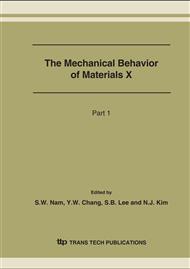p.485
p.489
p.493
p.497
p.501
p.505
p.509
p.513
p.517
Finite Element Simulation of Crack Propagation Under Mixed Mode Loading Condition Using Element Removing Method
Abstract:
In this study, we introduce an approach which simulates crack propagation under mixedmode loading condition. In comparison with the conventional element removing method which eliminates any element that satisfies a prescribed failure criterion near the crack tip, the present approach selects a set of elements ahead of the crack tip on the crack growth direction and removes them one by one when the element meets a prescribed failure criterion. Compact tension shear (CTS) specimens of type 304 stainless steel were used for failure testing. Finite element simulation has been carried out to simulate crack profiles and compared with observed ones. Results showed the proposed element removing algorithm is useful for crack growth simulation under mixed mode loading condition. The experimentally measured crack growth profile is in an agreement with the predicted ones.
Info:
Periodical:
Pages:
501-504
Citation:
Online since:
August 2007
Authors:
Price:
Сopyright:
© 2007 Trans Tech Publications Ltd. All Rights Reserved
Share:
Citation:


